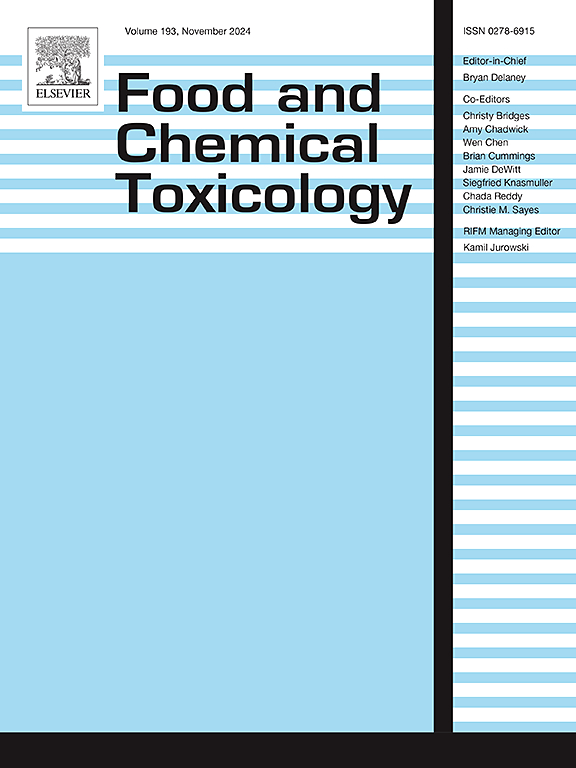Multivariate analysis of potentially toxic metal contents in soil and vegetables: Enrichment, bioconcentration, translocation from soil to vegetables, and assessment of human health toxicity
IF 3.9
3区 医学
Q2 FOOD SCIENCE & TECHNOLOGY
引用次数: 0
Abstract
The excessive accumulation of metals in agricultural soils can profoundly impact the quality of vegetables grown in contaminated soil. Understanding the bioaccumulation of these metals in vegetables is essential for assessing human exposure risks. The present study aimed to investigate the concentration of potentially toxic metals (PTMs: Fe, Mn, Cu, Zn, Al, As, Cr, Cd, and Pb) in agricultural soil and some commonly consumed vegetables (carrot, reddish, cauliflower, pumpkin, and spinach). The samples were collected from agrarian farmlands near the industrial area of Multan Road, Kasur-Pakistan. The mean contents of all metals in soil, root, and shoot samples were within the limits set by the EU, WHO, FAO, and US EPA, except for Cr in soil and Cr, Cd, and Pb in root samples. Across all analyzed vegetables, the bioconcentration factors (BCFroot and BCFshoot < 1, except As) and translocation factor (TF < 1) for all metals suggested that while these vegetables absorb metals, they generally do not accumulate or translocate them. Multivariate analysis indicated that both natural and anthropogenic activities contribute to metal contamination. The calculated hazard index (HI > 1) and cumulative cancer risk (CCR >1 × 10−3) values indicated the probability of non-carcinogenic and carcinogenic health risks for adults and children associated with the consumption of these vegetables. The findings provide critical insights for policymakers, agricultural regulators, and public health authorities to mitigate metal contamination risks and promote food safety.
土壤和蔬菜中潜在有毒金属含量的多元分析:富集、生物浓缩、从土壤到蔬菜的迁移以及人类健康毒性评估
农业土壤中金属的过量积累会严重影响污染土壤中蔬菜的质量。了解这些金属在蔬菜中的生物积累对于评估人类接触风险至关重要。本研究旨在调查潜在有毒金属(PTMs:铁、锰、铜、锌、铝、砷、铬、镉和铅)在农业土壤和一些常见蔬菜(胡萝卜、红菜、花椰菜、南瓜和菠菜)中的浓度。这些样本是从巴基斯坦卡苏尔木尔坦路工业区附近的农田收集的。除土壤中Cr和根样中Cr、Cd和Pb外,土壤、根和茎样中所有金属的平均含量均在EU、WHO、FAO和US EPA规定的限量范围内。在所有被分析的蔬菜中,生物浓缩因子(BCFroot和bcfrshoot <;1、除As外)和易位因子(TF <;1)对所有金属表明,虽然这些蔬菜吸收金属,但它们一般不积累或转运。多变量分析表明,自然活动和人为活动对金属污染都有影响。计算出的危害指数(HI >;1)和累积癌症风险(CCR >1 × 10−3)值表示与食用这些蔬菜有关的成人和儿童的非致癌和致癌健康风险的概率。研究结果为政策制定者、农业监管机构和公共卫生当局减轻金属污染风险和促进食品安全提供了重要见解。
本文章由计算机程序翻译,如有差异,请以英文原文为准。
求助全文
约1分钟内获得全文
求助全文
来源期刊

Food and Chemical Toxicology
工程技术-毒理学
CiteScore
10.90
自引率
4.70%
发文量
651
审稿时长
31 days
期刊介绍:
Food and Chemical Toxicology (FCT), an internationally renowned journal, that publishes original research articles and reviews on toxic effects, in animals and humans, of natural or synthetic chemicals occurring in the human environment with particular emphasis on food, drugs, and chemicals, including agricultural and industrial safety, and consumer product safety. Areas such as safety evaluation of novel foods and ingredients, biotechnologically-derived products, and nanomaterials are included in the scope of the journal. FCT also encourages submission of papers on inter-relationships between nutrition and toxicology and on in vitro techniques, particularly those fostering the 3 Rs.
The principal aim of the journal is to publish high impact, scholarly work and to serve as a multidisciplinary forum for research in toxicology. Papers submitted will be judged on the basis of scientific originality and contribution to the field, quality and subject matter. Studies should address at least one of the following:
-Adverse physiological/biochemical, or pathological changes induced by specific defined substances
-New techniques for assessing potential toxicity, including molecular biology
-Mechanisms underlying toxic phenomena
-Toxicological examinations of specific chemicals or consumer products, both those showing adverse effects and those demonstrating safety, that meet current standards of scientific acceptability.
Authors must clearly and briefly identify what novel toxic effect (s) or toxic mechanism (s) of the chemical are being reported and what their significance is in the abstract. Furthermore, sufficient doses should be included in order to provide information on NOAEL/LOAEL values.
 求助内容:
求助内容: 应助结果提醒方式:
应助结果提醒方式:


